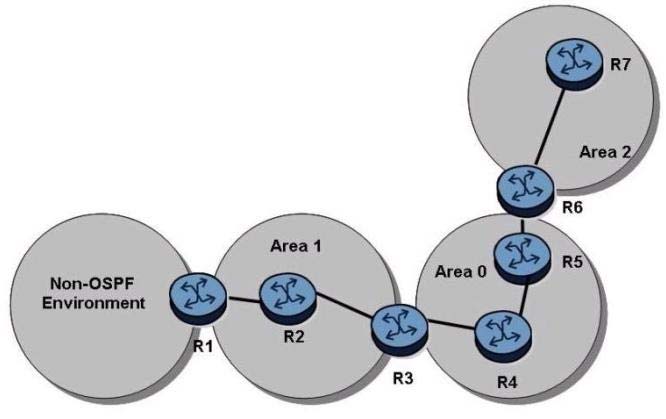Click the exhibit button.

In the topology shown, router R1 is an ASBR configured to export external routes to OSPF. Assuming that there are no stub networks, which of the following statements regarding Type 4 LSA generation is true?
Click the exhibit button.

In the topology shown, router R1 is an ASBR configured to export external routes to OSPF. Assuming that there are no stub networks, which of the following statements regarding Type 4 LSA generation is true?
In the OSPF (Open Shortest Path First) protocol, Type 4 LSAs (Link-State Advertisements) are generated by ABRs (Area Border Routers) to inform other routers how to reach the ASBR (Autonomous System Boundary Router). In this topology, Router R1 is the ASBR, and the responsibility of generating Type 4 LSAs falls on the ABRs in the network. Router R3 is the ABR between Area 1 and Area 0, while R6 is the ABR between Area 0 and Area 2. However, it's important to understand that Type 4 LSAs are not flooded across multiple areas if they do not need to be available to those areas. Since Router R3 is an ABR, it generates the Type 4 LSA for Area 0 (core area) and Area 2, but R6 does not generate any Type 4 LSA because Router R1 is not directly connected to Area 2. Therefore, Router R3 generates a Type 4 LSA that is flooded to areas 0 and 2.
FYI - Every ABR will inject a type 4 into its area. Even if not directly connected to the same area as the ASBR.
The type 4 LSA is an LSA that instructs the rest of the OSPF domain how to get to the ASBR so that others in the OSPF domain can route to external prefixes redistributed into OSPF by the ASBR. If we have no way to reach the ASBR that redistributed the routes, we obviously can’t reach the external route. Makes sense, right? So type 4 LSA tell the routing domain how to reach ASBRs to route outside its own doamin. However, we sometimes hear that ASBRs inject a type 4 LSA into OSPF. This is simply not true. The ABRs of the area where we have the ASBR are responsible for injecting type 4 LSAs to the adjacent areas.